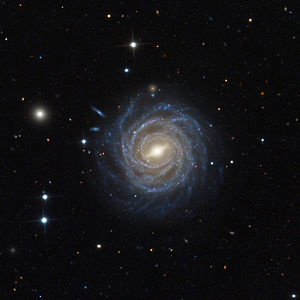NGC 521
| Galaxie NGC 521 | |
|---|---|
 | |
| Aufnahme der Spiralgalaxie NGC 521mithilfe des 81-cm-Spiegelteleskops des Mount-Lemmon-Observatoriums. | |
| AladinLite | |
| Sternbild | Walfisch |
| Position Äquinoktium: J2000.0, Epoche: J2000.0 | |
| Rektaszension | 01h 24m 33,82s[1] |
| Deklination | +01° 43′ 53″[1] |
| Erscheinungsbild | |
| Morphologischer Typ | SB(r)bc[2] |
| Helligkeit (visuell) | 11,7 mag[2] |
| Helligkeit (B-Band) | 12,5 mag[2] |
| Winkelausdehnung | 2,7′ × 2,4′[2] |
| Positionswinkel | 38°[2] |
| Flächenhelligkeit | 13,6 mag/arcmin²[2] |
| Physikalische Daten | |
| Zugehörigkeit | NGC 533-Gruppe[1] |
| Rotverschiebung | 0.016738 ± 0.000013[1] |
| Radialgeschwindigkeit | (5018 ± 4) km/s[1] |
| Hubbledistanz H0 = 73 km/(s • Mpc) | (227 ± 16) · 106 Lj (69,6 ± 4,9) Mpc [1] |
| Durchmesser | 180.000 Lj[3] |
| Geschichte | |
| Entdeckung | William Herschel |
| Entdeckungsdatum | 8. Oktober 1785 |
| Katalogbezeichnungen | |
| NGC 521 • UGC 962 • PGC 5190 • CGCG 385-106 • MCG +00-04-118 • IRAS 01219+0128 • 2MASX J01243377+0143532 • GC 304 • H II 461 • h 115 • LDCE 87 NED002 | |
NGC 521 ist eine Balken-Spiralgalaxie vom Hubble-Typ SBbc im Sternbild Walfisch südlich der Ekliptik. Sie ist schätzungsweise 227 Millionen Lichtjahre von der Milchstraße entfernt und hat einen Durchmesser von etwa 175.000 Lj.
Im selben Himmelsareal befinden sich die Galaxien NGC 533, IC 103, IC 105, IC 1694.
Die Supernovae SN 1966G (Typ-I), SN 1982O und SN 2006G (Typ-SN.II/IIb) wurden hier entdeckt.[4]
Das Objekt wurde am 8. Oktober 1785 von dem deutsch-britischen Astronomen Wilhelm Herschel entdeckt.[5]
Weblinks
Einzelnachweise
Auf dieser Seite verwendete Medien
Autor/Urheber: Ngc1535, Lizenz: CC BY-SA 4.0
Optics 32-inch Schulman Telescope (RCOS)
Camera SBIG STX16803 CCD Camera Filters Astrodon Gen II Dates November 2015 Location Mount Lemmon SkyCenter Exposure LRGB = 9 : 4 : 4 : 4 Hours Acquisition Astronomer Control Panel (ACP), Maxim DL/CCD (Cyanogen), FlatMan XL (Alnitak) Processing CCDStack, Photoshop, PixInsight Guest Astronomers Barry Boyce
Credit Line & Copyright Adam Block/Mount Lemmon SkyCenter/University of Arizona